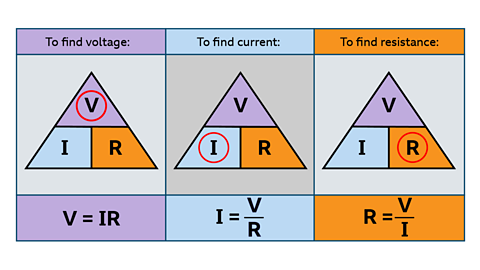How electronic quantities function in a circuit
- Current – the flow of electrons. The number of electrons passing a given point in one second. Current is measured in Amps and milliamps (A).
- Voltage – the force that makes electrons flow.Voltage (v) is measured in Volts and millivolts (V).
- Resistance - When a material resists the flow of electrons.Resistance is measured in ohms, kilo-ohms, mega-ohms (Ω).
Ohm's law
The quantities voltage, current and resistance are linked by the relationship:
Voltage = Current × Resistance
This relationship is called Ohm's Law. We usually write Ohm's Law as;
V=IR
- The symbol for resistance is R, it is measured in ohms (Ω).
- The symbol for voltage is V, it is measured in volts (V).
- The symbol for current is I, it is measured in amperes (amps) (A).
If given any two of these quantities, you will be able to work out the third.
The equation can be re arranged to work out any of the three quantities.
The triangle below can help you to remember the relationship.

V is equal to I multiplied by R; I equals V divided by R; and, R equals V divided by I.